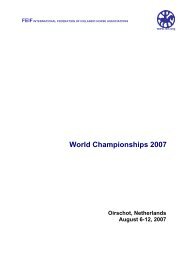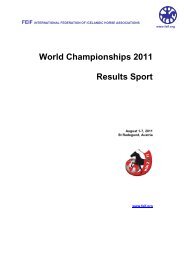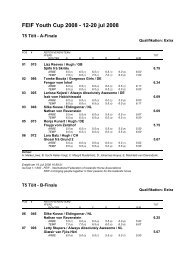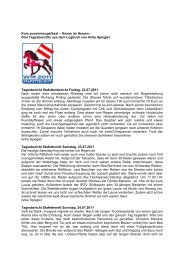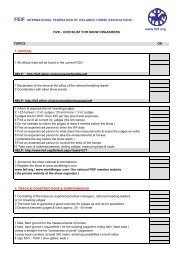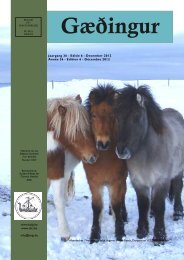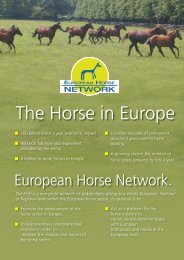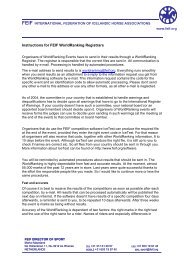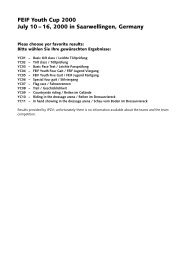FIZO 2010 - FEIFFengur
FIZO 2010 - FEIFFengur
FIZO 2010 - FEIFFengur
Create successful ePaper yourself
Turn your PDF publications into a flip-book with our unique Google optimized e-Paper software.
SECTION II Official definitions<br />
Breeding Standards<br />
1 st edition 1980. 1 st revision 2000, 2 nd revision 2002.<br />
Description of the Icelandic horse breed<br />
<strong>FIZO</strong> <strong>2010</strong> E-2<br />
Origin<br />
The Icelandic horse breed originates from Iceland where it has been bred,<br />
without any known introduction of foreign genetic material, since the island was<br />
settled around the year 900 AD. Its closest relatives today are assumed to be<br />
the native horse breeds of Scandinavia and horse breeds of the British Isles.<br />
The Icelandic horse is pure-bred with all ancestors traceable to Iceland.<br />
Size<br />
The height of the Icelandic horse generally ranges from 125 to 145 cm when<br />
measured with a stick at the highest point of the withers. The average for mares<br />
is 136 cm and for stallions 138 cm. The fully mature Icelandic horse weighs<br />
around 300 kg to 400 kg.<br />
Colours<br />
Most known horse colours and markings can be seen. The most dominant<br />
colours are chestnut, black and bay but grey and tobiano are also quite<br />
commonly found. More than one hundred colour varieties may be found in the<br />
Icelandic horse breed.<br />
Conformation<br />
Conformation may vary considerably but a typical Icelandic horse is rectangular<br />
and compact in shape. Typical of the breed is a sloping croup, a long, thick<br />
mane and tail, and a thick, protective coat in winter.<br />
Performance<br />
The Icelandic horse is a riding horse. The horse is unique in its gaits and<br />
virtually all Icelandic horses have tölt in addition to walk, trot, and canter/gallop.<br />
Many horses have the additional gait of very fast (flying) pace. As a riding horse<br />
it is extraordinarily versatile - a capable, willing horse for pleasure riding, and for<br />
sport competitions, suitable for adults and children. The horse is tough,<br />
independent, yet sociable and easy to get on with, is self-assured and has good<br />
staying power.<br />
Longevity<br />
The horse matures slowly and is generally not fully grown until the age of six or<br />
seven. It has a long active life span (25-30 years is not unusual).<br />
Health<br />
The overall health of the Icelandic horse is very good. Fertility is high and both<br />
sexes can be fit for reproduction up to the age of 25 to 27 years.



